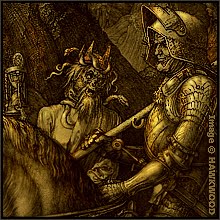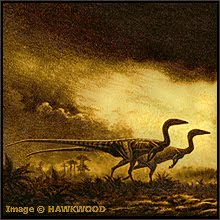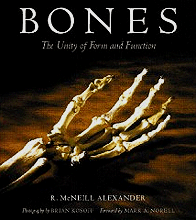One of the most justly-famous fossil finds in dinosaur studies was the group unearthed in 1964 in Montana by the late Professor John Ostrom. The group consisted of the remains of the herbivore Tenontosaurus, together with between three to four individuals of a newly-discovered carnivorous dinosaur that was given the name of Deinonychus antirrhopus (literally: 'Terrible-claw/counterbalance'). What so excited the world of palaeontology was that the group appeared to show, not merely evidence of active predation, but a coordinated effort by predators to bring down a herbivore. In short: the Deinonychus were co-operating as a pack to hunt and kill the much larger Tenontosaurus.
Not surprisingly, this find was gratefully seized upon by palaeoartists as a worthy subject; not just because of its significance, but because of the possibilities which it offered for portraying some real down-and-dirty dinosaur action, while remaining faithful to the fossil material. When I came to produce my own version (above), I decided to use the tails of the animals as a compositional device to convey the drama of the kill. From their fossil remains, we know that Deinonychus had relatively inflexible tails, presumably to act as an effective counterbalancing rudder (hence 'antirrhopus') when running and turning. And for a herbivore of its type, Tenontosaurus had an unusually long tail.
My first rough pencil sketch (above) utilised these tails as a device for focusing the action towards the point of attack. This sort of worked, but with the predators coming from all sides, it did not completely convey the effect that I was after: that the Tenontosaurus was literally being knocked off balance by the ferocity of the attack. My second more detailed pencil drawing (below) placed the two Deinonychus at the hindquarters of their prey, which gave all four tails - both of predators and of prey - a uniform thrust, as if driven by an unstoppable force of fate. This seemed to work more effectively, and I scanned in the drawing and continued to work on it digitally, painting in the lighting effects and colors with digital brushes.
The deposits of the find indicate that the encounter took place on the bed of a dried-out river or delta, probably close enough to the undercut bank for the earth to have collapsed and hastened the animals' burial. I freely admit that using back-lit dust is a favorite device of mine for injecting atmosphere into such a scene, so this setting was from my point of view ideal. By altering the drawing so that the tenontosaur's forelegs were folded away out of balance, I now had the effect of it being knocked off its feet by the force of the Deinonychus impacting its body. The second Deinonychus was now also falling (the detail, below), and clearly in danger of having its skull crushed beneath its prey, which conveyed the idea that predators as well could be - and often are - the victims of their own attack. Active hunting can be a dangerous pursuit.
And so, in apparent faithfulness to the fossil material, I (and other paleoartists) dutifully portrayed one Tenontosaurus being attacked by three (or four) Deinonychus, with the clear implication that the raptors were coordinating their attack with each other. Thus portrayed (and whomever paints it), it has become one of the iconic images of paleo art; and the pack behaviour of raptors - and the implied intelligence required - was cheerfully made further use of in the Jurassic Park scripts. But is this really the way things were on that dusty Montana river bed some one hundred and thirteen million years ago? Even given the specifics of the fossil evidence, how can we be so sure?
It is both illuminating and rather sobering to look at Ostrom's original map of the site. This scattered tangle of fossil bones is what Ostrom actually had to work with. We know for certain that at least three Deinonychus and one Tenontosaurus died here. But that is all. There can be no way of knowing whether or not the raptors truly were acting co-operatively, or whether they were there just joining in an opportunistic meal when death, perhaps in the form of the collapsed river bank, overtook them. It is even possible, and has been *suggested, that a scavenging frenzy took place, in which other Deinonychus turned upon their own kind for a cannibalistic feast. But a truly coordinated pack attack, as practiced by wolves, wild dogs, and other such carnivorous mammals, is assumption.
And even if Deinonychus was intelligent as predatory dinosaurs go, this is still a long way from the intelligence and social interaction of mammals.
And the fossils record only the dead. How many other animals were originally at the scene which simply lived and walked away? My painting depicts a lone tenontosaur, but there might have been several of these herbivores present, with only one falling victim, both to the raptors and to the processes of fossilization. Over the border in Wyoming another such site has been found. But this second site reveals the remains of no less than six tenontosaurs - and only one solitary Deinonychus. The scarily social and rationalising raptors of Jurassic Park were, after all, movie dinosaurs. Palaeontology must cope with situations which, as often as not, offer more than one viable scenario.
Hawkwood
Sources:
Ostrom, John H.: 'Osteology of Deinonychus antirrhopus, an unusual theropod dinosaur from the Lower Cretaceous of Montana'. New Haven: Peabody Museum of Natural History, Yale University, 1969. Series: Yale University. Peabody Museum of Natural History. Bulletin 30.
Parsons, William L., and Parsons, Kristen M.: 'Further descriptions of the osteology of Deinonychus antirrhopus (Saurischia, Theropoda)'. Bulletin of the Buffalo Society of Natural Sciences, Volume 38, 2009.
*Roach, Brian T., and Brinkman, Daniel L.: 'A Reevaluation of Cooperative Pack Hunting and Gregariousness in Deinonychus antirrhopus and Other Nonavian Theropod Dinosaurs'. Bulletin of the Peabody Museum of Natural History 48(1):103–138, April 2007.


























Very nice work, nice to see the development in sketches
ReplyDelete